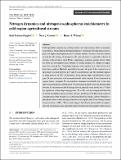Nitrogen dynamics and nitrogen-to-phosphorus stoichiometry in cold region agricultural streams
Metadata
Afficher la notice complèteAuthor
Friesen-Hughes, Karl
Casson, Nora J.
Wilson, Henry F.
Date
2021-05-12Citation
Friesen-Hughes, Karl, Nora J. Casson, and Henry F. Wilson. "Nitrogen dynamics and nitrogen-to-phosphorus stoichiometry in cold region agricultural streams." Journal of Environmental Quality 50 (2021): 653–666. DOI: 10.1002/jeq2.20234.
Abstract
Cold agricultural regions are getting warmer and experiencing shifts in precipitation patterns, which affect hydrological transport of nutrients through reduced snowpack and higher annual proportions of summer rainfall. Previous work has demonstrated that the timing of phosphorus (P) concentrations is regionally coherent in streams of the northern Great Plains, suggesting a common climatic driver. There has been less investigation into patterns of stream nitrogen (N), despite its importance for water quality. Using high-frequency water quality data collected over 6 yr from three southern Manitoba agricultural streams, the goal of this research was to investigate seasonal patterns in N and P concentrations and the resultant impacts of these patterns on N/P stoichiometry. In the spring, high concentrations of inorganic N were associated with snowmelt runoff, while summer N was dominated by organic forms; inorganic N concentrations remained consistently low in the summer, suggesting increased biological N transformation and N removal. Relationships between N concentration and discharge showed generally weak model fits (r2 values for significant relationships ranging from .33 to .48), and the strength and direction of model fits differed among streams, seasons, and forms of N. Dissolved organic N concentrations were strongly associated with dissolved organic carbon. Nitrogen-to-phosphorus ratios varied among streams but were significantly lower during summer storm events (p < .0001). These results suggest that climate-driven shifts in temperature and precipitation may negatively affect downstream water quality in this region.

